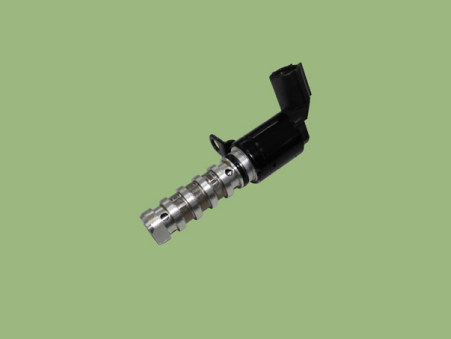Kia Niro: Engine Control System / CVVT Oil Control Valve (OCV) Description and operation
| Description |
Continuous Variable Valve Timing (CVVT) system advances or retards the valve timing of the intake and exhaust valve in accordance with the ECM control signal which is calculated by the engine speed and load.
By controlling CVVT, the valve overlap or underlap occurs, which in turn improves fuel efficiency, reduces exhaust gases (NOx, HC) and improves engine performance by reducing pumping loss, generating internal EGR effect, improving combustion stability, improving volumetric efficiency and increasing expansion work.
This system consists of
-the CVVT Oil Control Valve (OCV) which supplies the engine oil to the cam phaser or cuts the engine oil from the cam phaser in accordance with the ECM PWM (Pulse With Modulation) control signal,
- the CVVT Oil Temperature Sensor (OTS) which measures the engine oil temperature,
-and the Cam Phaser which varies the cam phase by using the hydraulic force of the engine oil.
The engine oil released from the CVVT oil control valve varies the cam phase in the direction (Intake Advance/Exhaust Retard) or opposite direction (Intake Retard/Exhaust Advance) of the engine rotation by rotating the rotor connected with the camshaft inside the cam phaser.
[Bank 1 / Exhaust]

 CVVT Oil Control Valve (OCV) Specifications
CVVT Oil Control Valve (OCV) Specifications
Specification
Item
Specification
Coil Resistance (Ω)
6.9 - 7.9 [20°C(68°F)]
Rated Voltage (V)
12
...
 CVVT Oil Control Valve (OCV) Schematic diagrams
CVVT Oil Control Valve (OCV) Schematic diagrams
Circuit Diagram
Harness Connector
OCV [B1/EX]
...
Other information:
Kia Niro 2017 (DE HEV) Service Manual: Memory power seat switch Repair procedures
Removal
1.
Disconnect the negative (-) battery terminal.
2.
Remove the driver front door trim.
(Refer to Body - "Front Door Trim")
3.
Remove the memory power seat switch (A) after loosening the mounting
...
Kia Niro 2017 (DE HEV) Service Manual: Blower Motor Repair procedures
Inspection
1.
Operate the heater controls at IGN2 to ensure that the motor is running.
1. Battery (+)
2. Input signal
3. ?
4. Ground
2.
If the blower motor does ...
